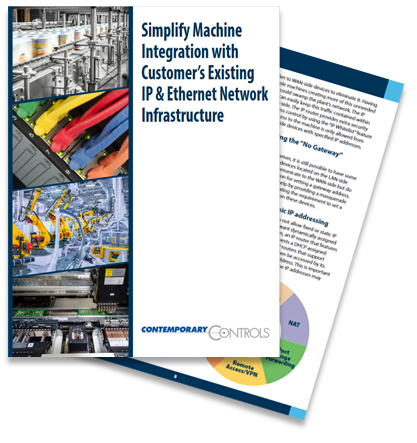Control Network Newsletter

Simplify Machine Integration with Customer's Existing IP & Ethernet Network Infrastructure
 Modern machines are comprised of various complex subsystems that communicate via the Internet Protocol (IP). The machine builder pre-defines each subsystem IP address and the range of addresses devoted to each machine. This addressing convention may conflict with the addressing policies of the customer, potentially jeopardizing a speedy integration of the machine or machines to the plant.
Modern machines are comprised of various complex subsystems that communicate via the Internet Protocol (IP). The machine builder pre-defines each subsystem IP address and the range of addresses devoted to each machine. This addressing convention may conflict with the addressing policies of the customer, potentially jeopardizing a speedy integration of the machine or machines to the plant.
This whitepaper examines how an IP router can quickly and effectively integrate these machines to the customer's existing IP infrastructure, benefiting both customer and machine builder alike. Additionally, industrial-grade managed, unmanaged, and diagnostic Ethernet switches provide a robust and reliable infrastructure that is beyond par than commercial grade equipment.
The various IP components of the machine are assigned IP addresses, and the application controlling these various subsystems is programmed to communicate to these subsystem devices using their IP addresses. A machine builder then ships this tested machine to the customer but the IP addresses being used at the customer's site are most probably different than what was tested at the machine builder's factory. Changing the IP addresses on the machine and modifying the control program to communicate with revised IP addresses to comply with the customer's IP address requirements adds significant time to the commissioning process and hinders the ability to bring the machine on-line quickly.
The use of an IP router, like Contemporary Controls' EIPR/EIGR, allows the machine's IP addresses to remain unchanged.
The IP router consists of two networks, one network is the internal local-area-network (LAN); the other is the external wide-area-network (WAN). The machine is connected to the internal network and the external network is connected to the plant which can be easily changed to comply with the plant's IP requirements. The various machine subsystems are presented as one device to the plant network but can be easily accessed individually by using various features of the IP router, such as Port Forwarding, Port Range Forwarding and NAT.
Adding an IP router to the machine provides multiple options that make it easy to integrate the machine to the IP infrastructure of the plant.
To learn more, download Simplify Machine Integration with Customer's Existing IP & Ethernet Network Infrastructure (PDF).